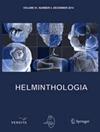一氧化氮合酶在旋毛虫护士细胞中神经元形式的下调
IF 1.2
4区 生物学
Q4 PARASITOLOGY
引用次数: 0
摘要
摘要 自由基一氧化氮(NO)和 Ca2+ 是骨骼肌运动表现和疲劳的关键调节因子。骨骼肌细胞中一氧化氮的主要来源是一氧化氮合酶(nNOS)的神经元形式。旋毛虫(T. spiralis)的护士细胞最奇特的特征之一是完全丧失其衍生横纹肌纤维的收缩能力。本研究的目的是明确小鼠感染螺旋体后肌肉阶段横纹肌中 nNOS 蛋白和 mRNA 的表达情况。小鼠在感染后第 0、14、24 和 35 天(d.p.i.)采集肌肉组织样本。用免疫组化法检测 nNOS 的表达,用实时 PCR 检测小鼠一氧化氮合酶 1(Nos1)mRNA 的表达水平。在感染的早期阶段,解体的肌浆中仍可观察到 nNOS 蛋白的存在。发育成熟的护士细胞的细胞质中则没有这种蛋白。至少在护士细胞发育初期,旋毛虫会利用任何创伤后诱发的骨骼肌细胞修复过程,这与我们在第 14 天p.i.时的 nNOS 表达结果非常吻合。不过,在后期阶段,我们可以认为,螺旋体护士细胞中 nNOS 的下调要么具有保护功能,要么是护士细胞遗传特性的结果。本文章由计算机程序翻译,如有差异,请以英文原文为准。
Down-regulation of neuronal form of Nitric oxide synthase in the Nurse cell of Trichinella spiralis
Summary The free radical nitric oxide (NO) and Ca2+ are critical regulators of skeletal muscle exercise performance and fatigue. The major source of NO in skeletal muscle cells is the neuronal form of the enzyme Nitric oxide synthase (nNOS). One of the most peculiar characteristics of the Nurse cell of Trichinella spiralis (T. spiralis ) is the complete loss of the contractile capabilities of its derivative striated muscle fiber. The aim of the present study was to clarify the expression of nNOS protein and mRNA in striated muscles during the muscle phase of T. spiralis infection in mice. Muscle tissue samples were collected from mice at days 0, 14, 24, and 35 post infection (d.p.i.). The expression of nNOS was investigated by immunohistochemistry, and the expression levels of mRNA of mouse Nitric oxide synthase 1 (Nos1) by real-time PCR. The presence of nNOS protein was still well observable in the disintegrated sarcoplasm at the early stage of infection. The cytoplasm of the developing and mature Nurse cell showed the absence of this protein. At least at the beginning of the Nurse cell development, Trichinella uses the same repairing process of skeletal muscle cell, induced after any trauma and this corroborates very well our results concerning the nNOS expression on day 14 p.i. At a later stage, however, we could suggest that the down-regulation of nNOS in the Nurse cell of T. spiralis either serves a protective function or is an outcome of the genetic identity of the Nurse cell.
求助全文
通过发布文献求助,成功后即可免费获取论文全文。
去求助
来源期刊

Helminthologia
生物-动物学
CiteScore
1.80
自引率
0.00%
发文量
21
审稿时长
>12 weeks
期刊介绍:
Helminthologia (HELMIN), published continuously since 1959, is the only journal in Europe that encompasses the individual and collaborative efforts of scientists working on a different topics of human, veterinary and plant helminthology. The journal responsibility is to enrich the theoretical and practical knowledge in very specific areas and thus contribute to the advancements in human and veterinary medicine and agronomy. Taking the advantage of comprehensive and multidisciplinary approaches journal still maintains its original spirit and is principal source of fresh scientific information regarding helminths, endoparasites and plant parasites. Addressing the most up-to date topics journal gained rightful and exceptional place next to the other high-quality scientific journals publishing in its field.
 求助内容:
求助内容: 应助结果提醒方式:
应助结果提醒方式:


